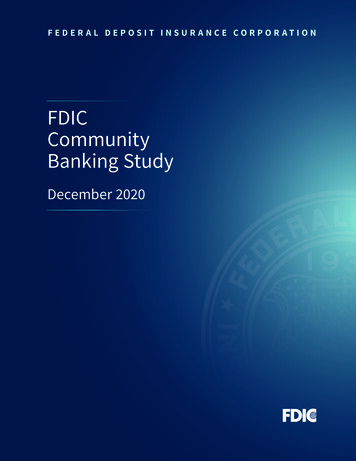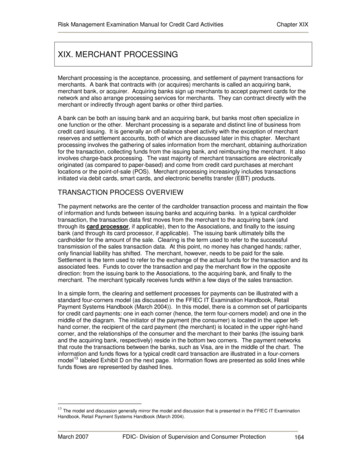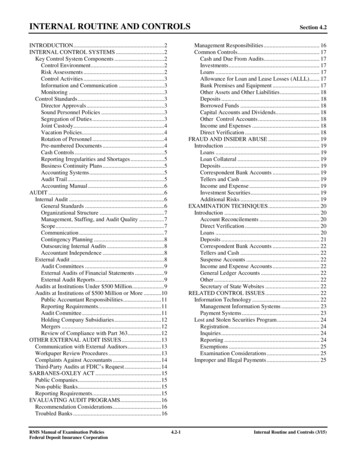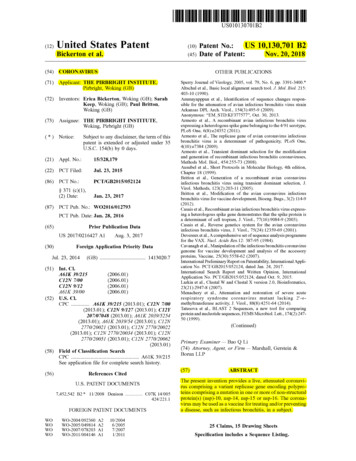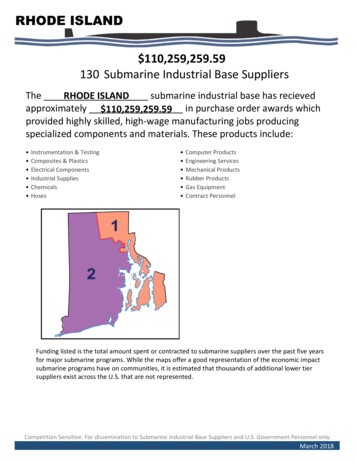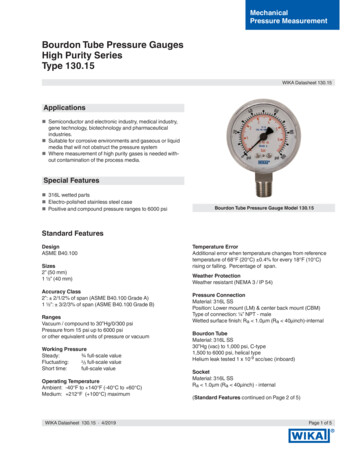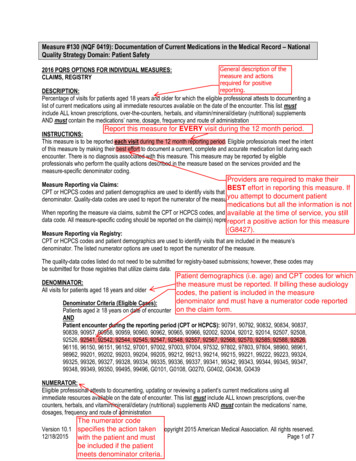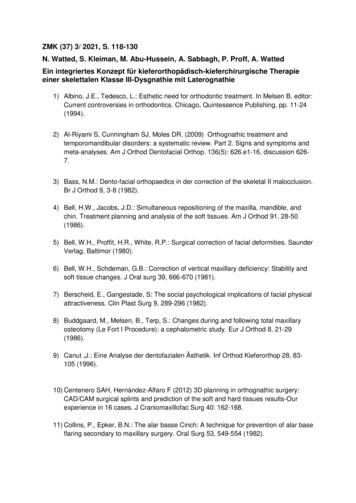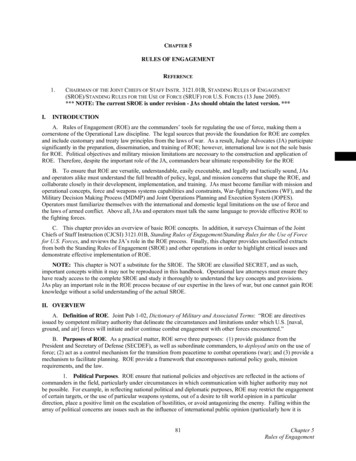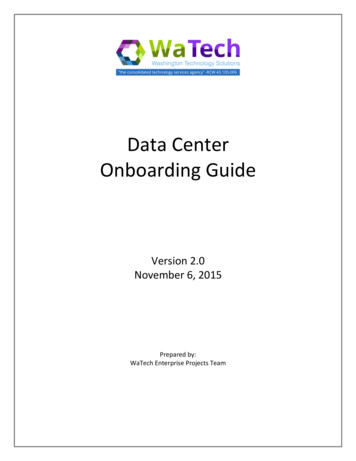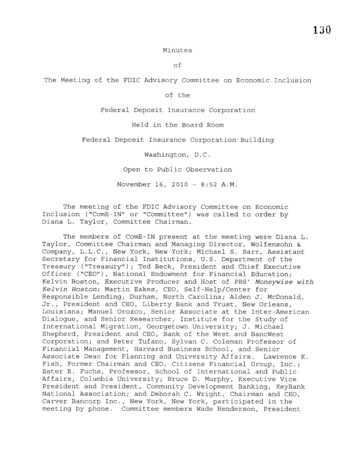
Transcription
130MinutesofThe Meeting of the FDIC Advisory Committee on Economic Inclusionof theFederal Deposit Insurance CorporationHeld in the Board RoomFederal Deposit Insurance Corporation BuildingWashington / D. C .Open to Public ObservationNovember 16/2010 - 8:52 A.M.The meeting of the FDIC Advisory Committee on EconomicInclusion ("ComE-IN" or "Committee") was called to order byDiana L. Taylor / Committee Chairman.The members of ComE- IN present at the meeting were Diana L.Taylor / Committee Chairman and Managing Director / Wolfensohn &Company / L. L. C. / New York, New York; Michael S. Barr / AssistantSecretary for Financial Institutions / U. S. Department of theTreasury ("Treasury"); Ted Beck, President and Chief ExecutiveOfficer ("CEO") / National Endowment for Financial Education;Kelvin Boston, Execut i ve Producer and Host of PBS / Moneywi se wi thKel vin Boston; Martin Eakes / CEO / Self -Help/Center forResponsible Lending / Durham, North Carolina; Alden J. McDonald,Jr. / President and CEO / Liberty Bank and Trust / New Orleans /Louisiana; Manuel Orozco / Senior Associate at the Inter-AmericanDialogue / and Senior Researcher / Institute for the Study ofInternational Migration, Georgetown Uni versi ty; J. MichaelShepherd, President and CEO, Bank of the West and BancWestCorporation; and Peter Tufano / Sylvan C. Coleman Professor ofFinancial Management / Harvard Business School/and SeniorAssociate Dean for Planning and Uni versi ty Affairs. Lawrence K.Fish, Former Chairman and CEO, Citizens Financial Group, Inc.;Ester R. Fuchs / Professor / School of International and PublicAffairs, Columbia University; Bruce D. Murphy, Executive VicePresident and President / Community Development Banking / KeyBankNational Association; and Deborah C. Wright / Chairman and CEO,Carver Bancorp Inc. / New York, New York, participated in themeeting by phone. Committee members Wade Henderson, President
131and CEO / Leadership Conference on Civil Rights / and Counselor tothe Leadership Conference on Civil Rights Education Fund; Rev.Dr. Floyd H. Flake / Senior Pastor / Greater Allen AME Cathedral ofNew York; Rebecca W. Rimel/President and CEO / The PEW Chari tableTrusts; John W. Ryan, Executive Vice President / Conference ofState Bank Supervisors; and Robert K. Steel/Deputy Mayor forEconomic Development / The City of New York, New York, were absentfrom the meeting.Members of the Federal Deposit Insurance Corporation' s("Corporation" or "FDIC") Board of Directors present at themeeting were Sheila C. Bair / Chairman, Martin J. Gruenberg / ViceChairman, and Thomas J. Curry, Director (Appointive). Roberta K.McInerney / Designated Federal Officer for the Committee andDeputy General Counsel/Corporate / Consumer / Insurance / andLegislation Branch, FDIC Legal Division, also was present at themeeting. Corporation staff who attended the meeting includedGeorge C. Alexander / Michael J. Barry / Heather L. Basnett /Michael W. Briggs / Luke H. Brown, Richard A. Brown, Karyen Chu,Glenn E. Cobb / Patricia B. Devoti / Robert E. Feldman, Janet R.Gordon, Leneta G. Gregorie, Tray Halverson, Greg Hernandez, SallyJ. Kearney / Kenyon T. Kilber / Michael H. Krimminger / Alan W.Levy / Ellen W. Lazar / Rae-Ann Miller / Janet V. Norcom, Luke W.Reynolds, Sherrie Rhine, Barbara A. Ryan, Kimberly Stock, JamesC. Watkins / and Cathie A. Wright.Committee Chairman Taylor opened and presided at themeeting. She began by welcoming ComE- IN members and providing anoverview of the meeting agenda. Next / Chairman Bair announcedthat Elizabeth Warren had resigned her Committee membership toconcentrate on her new responsibilities as Assistant to thePresident and Special Advisor to the Secretary of the Treasury onthe new Consumer Financial Protection Bureau ("CFPB") / andexpressed thanks to Ms. Warren for her outstanding service duringher tenure on the Committee. She then provided a brief update onpast initiatives of the Committee.Chairman Bair recalled that the Committee had previouslydiscussed whether the FDIC would consider conducting a pilot tohelp identify best practices of banks offering safe and low-costtransaction and savings accounts / particularly those responsiveto the needs of underserved and unbanked consumers / and reportedthat the FDIC Board of Directors had approved the pilot andCommi ttee-reviewed transaction and savings account templates.She then advised that / as the result of the ensuing applicationprocess, nine applicants had been selected to participate in thepilot and announced that the nine pilot banks were Bath SavingsInsti tution, Bath, Maine; Cross County Federal Savings Bank,Middle Village, New York; First State Bank, Union City,November 16/ 2010
132Tennessee; Liberty Bank and Trust / New Orleans / Louisiana;Pinnacle Bank / Lincoln / Nebraska; South Central Bank, Glasgow /Kentucky; Webster Five Cent Savings Bank, Webster / Massachusetts;Citibank, National Association, Las Vegas, Nevada; and ING Bank,FSB, Wilmington, Delaware. She further advised that each of thenine pilot banks had agreed to offer accounts consistent with therecommended templates and provide quarterly data aboutenrollment / usage / and account costs / which would allowaggregation of the data and sharing of results wi th other banksthat have an interest in offering similar accounts.Chairman Bair next announced that the FDIC, consistent withpast advice of the Committee / had just entered into an historicpartnership agreement with the U. S. Department of Education("DOE") and the National Credit Union Administration ("NCUA") topromote financial education and financial access among youth inthe United States, with the agreement calling for the FDIC andthe NCUA to support DOE in training more than one million lowincome students in the basics of personal finance and soundfinancial practices. She expressed excitement about the program,optimism that the agreement would lead to more financialinstitutions partnering with schools, and, noting the FDIC' shistory of support for financial education through its MoneySmart curriculum, a belief that the partnership would provide theFDIC with additional data on the impact of the curriculum onfinancial behavior. Concluding her remarks / Chairman Bairindicated an interest in hearing the Committee / s views aboutother concrete steps the FDIC can take to advance children' ssavings accounts and related literacy issues. She then turnedthe discussion over to Professor Tufano.Professor Tufano, noting the current sense of urgency aroundthe rethinking of consumer financial rules and regulations andthe establishment of the CFPB, introduced the concept of usingmarket research to inform the regulatory agenda. To illustratethe concept / he briefed the Committee on the results of anational/internet -based study of Americans he conducted inOctober 2010 in conjunction with TNS, a global market researchfirm, to measure overall satisfaction with financial regulationand identify what he referred to as regulatory "pain points."Regarding overall satisfaction with financial regulation, headvised that the study asked the degree to which respondentsthink their household financial interests are currently protectedby laws and regulations and that 46 percent of respondentsindicated they were appropriately protected / 28 percent indicatedthey were not appropriately protected, and 27 percent indicatedthey were neither appropriately nor not appropriately protected.He further advised that among the 28 percent of respondents whoreported feeling less well protected, one could add 6 to 11November 16/ 2010
133points for those who say they carry some debt; 16 to 25 pointsfor those who say they are over-indebted; 11 to 12 points forthose who indicate they would be unable to raise 2/ 000 wi thin 30days; 7 to 8 points for those who use mortgage products; 5 to 9points for those who carry credit card balances; and 7 to 8points for those who use alternative financial services ("AFS")products. Regarding regulatory pain points / he reported thatrespondents were most dissatisfied, in order of priority / withfees on credi t cards / interest rates charged on credit cards /terms on credit cards / the level of fees on overdraft protection,activity to identify and stop fraudulent investments and theirpromoters / and deal ing with fraudulent lenders.Chairman Bair asked whether mortgages were one of thefinancial product categories included in the study / in responseto which Professor Tufano stated that they were included; thatmortgages fell somewhere in the middle of products wi th whichrespondents were most and least dissatisfied; and that / amongmortgage-related issues, respondents were most dissatisfied withnegotiating mortgage modifications, followed by terms of homemortgages and shopping for and comparing mortgage offers.Next / Professor Tufano provided context for the panelpresentations on children / s savings accounts / noting thatapproximately 4.3 million children are born each year in theUnited States; that about 20 percent of children are members ofpoor families, with about one-third of Black and Hispanicchildren living in poverty; that / when discussing the possibilityof establishing universal savings accounts, it is important to becognizant of reaching the 20 to 25 percent of children born intoless than ideal circumstances and to take into account themobility of the U. S. population; and that a variety of theoriesunderlie the logic of children' s savings accounts, includingstarting the savings habit early to employ the power of compoundinterest / supporting asset building / addressing the issue ofintergenerational transmission of poverty and opportunity / andgetting children into what he referred to as the "plumbingsystem" of the financial world as a j umpstart to encouragingfinancial 1 i teracy and other savings. He then introduced hi sfellow panelists / José Cisneros / Treasurer for the City andCounty of San Francisco; Robert A. Annibale / Global Director /Ci tibank Microf inance and Community Development; KatrynGabrielson, Deputy General Counsel/Finance Authority of Maine;and Robert Friedman, General Counsel/Founder / and Chairman ofthe Board / CFED.Mr. Cisneros / after underscoring San Francisco / s commitmentto financial empowerment programs, including the city' s Bank OnSan Francisco program and its Payday Plus SF program, providedNovember 16/ 2010
134background on a more recent ini tiati ve / the soon-to-be launchedKindergarten to College ("K2C") program. He explained that itwould be the first universal child savings account program, thatit would be administered by reaching out to children enrolled inthe public school system, and that San Francisco is well-suitedfor such a program because it has the lowest number of childrenper capita of any major city in the nation; it has a significantpercentage of children living in poverty; it has a school systemthat is incredibly diverse / with a large immigrant population;and nearly 70 percent of its public school graduates enroll inpost-secondary education. Pointing to studies that show thatchildren wi th any amount of money saved for college are manytimes more likely to attend college than those who have saved nomoney, he identified as the goals of the program creating acollege-going culture / reducing exclusion from the financialmainstream, increasing financial literacy/and leveraging privateinvestments in San Francisco families.Next addressing program design, Mr. Cisneros advised that itincluded automatic enrollment, universality, and a publiclyfunded seed deposit / with each child entering kindergarten in apublic school receiving an account with an initial deposit of 50and an additional 50 for children eligible for the free andreduced lunch program; opportunities for matched savings andincent i ves through private funding sources; a range of depositoptions; and financial education for the children and theirfamilies. He then identified as some of the program challengesobtaining the information necessary for auto-enrollment / whichwas mitigated by working with the school system; findingfinancial providers willing to administer large numbers of smalldollar accounts / which was solved through a partnership withCitibank; and the local budget climate, which served as animpediment to getting the program approved. As for accountstructure / Mr. Cisneros indicated that the Ci ty would establishan escrow account with its own tax identification number, withsubaccounts for each child; that signed consent forms would beobtained from parents to gain access to the information necessaryto manage incentives; and that the City would assumeresponsibility for tracking incentives and matches. He furtherindicated that the K2C program has a phased rollout. Concludinghis remarks / he identified some of the key program partners /including the Mayor' sand Treasurer' s offices / the Department ofChildren, Youth and Families, and the San Francisco UnifiedSchool District; non-profit organizations such as EARN, CFED, andthe New America Foundation; and research and evaluation partnersfrom Stanford Uni versi ty. Al though acknowledging the challengesahead, Mr. Cisneros said that he looked forward to working withregulators and financial institutions and to successful evolutionof the program.November 16/ 2010
135Mr. Annibale began by emphasizing Citibank' s extensivehistory of philanthropic work in the area of matched savingsprograms and noting that / while many of these efforts haveproduced positive outcomes, these efforts have not beenfinancially sustainable and have not reached the hoped for scale.He stated that / as a resul t / Ci tibank set out to develop abanking platform that would support large-scale / lower-size / lowcost / but very accessible transactions for student ini tiati ves /with the development effort leading to a new Custodial AccountStructure that allows for universal or wide-scale enrollment /with the program sponsor determining eligibility for enrollmentand the program administrator handling enrollment; provide simpleaccount management and incentive tracking, with on-line access byparticipants to their individual accounts; of fer easy- to-buildsavings, with the option to make deposits at Citibank branches orvia direct deposit / wire transfers / or mail; and engage studentsinteractively through technology to keep them active over aperiod of time. Observing that there are a number of players inthe program model, Mr. Annibale identified those players as thebank, which provides the product / the platform and the technologythat houses the accounts and provides easy access through acustomized website; the schools / which have primaryresponsibili ty for engaging students and parents; theadministrator / which opens and manages the accounts and programguidelines; and the custodian, which owns the accounts / with theadministrator and custodian sometimes being the same entity. Hethen advised that the next steps in the student account processare enrollment of students and starting to savei with the bestway of reaching large numbers of children being through schoolsystems; learning to save through incentives, competitions,games / and awards built into the school curriculum; and /ul timately / enrollment of participants into college / at whichtime participants gain access to their funds.In conclusion / Mr. Annibal e expressed conf idence that theCustodial Account Structure is one that offers easy opening /scale / and a low enough operating cost to be attractive to otherorganizations. He said that / in fact / since the City of SanFrancisco had announced its program, Citibank has alreadyreceived interest from other cities and school systems. Advisingthat the webs i t e ,""1¡ 1¡ : i:y§: y :rg§è3C: ()"Lr:!::g "1 9 / would soon go 1 i ve /he expressed hope that it will be the basis for building tens ofthousands of accounts in a relatively short period andestablishing a good partnership between Citibank and programsponsors.Ms. Gabrielson then briefed the Committee on the HaroldAlfond College Challenge ("Challenge") administered by theNovember 16/ 2010
136Finance Authority of Maine ("FAME") for the Alfond ScholarshipFoundation ("Foundation") through NexGen. She explained thatChallenge is a legacy gift of 500 toward higher educationexpenses for every Maine resident baby / regardless of familyincome, and that it is also a challenge to the State of Maine toget all Maine families thinking about the need for and thepossibili ty of higher education. She noted that / if each of14/ 000 Maine babies took advantage of the grant each year / thefoundation would be funding 7 million annually. Furtherexplaining the program, she stated that the funds are invested inMaine' s Section 529 Plan, that the account must be opened by thebaby' s first birthday / that the funds are available for qualifiededucation expenses up to age 28/ and that additionalcontributions are encouraged, but not required.Next discussing some of the program challenges / Ms.Gabrielson advised that getting timely and complete applicationsis often difficult because some residents think the offer is toogood to be true and ignore it / there is often a wait encounteredfor Social Security numbers after the birth of a baby / theapplication can be daunting for those with literacy issues, andthe one-on-one approach that has proved to be the best foropening accounts is also the most costly. As for how thechallenges have been met / she said that FAME has establishedpartnerships with hospitals / physicians / groups / financialadvisors / employers / banks / and other institutions that are onthe front lines with families to raise awareness about theavailabili ty of the grant / especially during the pre-natal stage;that it conducts "casting calls /" generally held at malls /offering free professional baby photographs / which is then usedas an opportunity to market the program and to assist withcompletion of applications; that FAME employs the Bureau of VitalStatistics to conduct direct marketing through mailings tofamilies; and that the Foundation works to raise awareness aboutthe advantages of higher education through quarterly brochures ona variety of topics and provides quarterly account summaries toaccountholders. Regarding the role of banks / Ms. Gabrielsonindicated that they act as a bridge to the investment product /distributing enrollment and Alfond materials, and that they oftenoffer matching contributions to employees as an employee benefitor to customers as a customer bonus. She stated that / thus far /the program has seen the enrollment of 7/000 within two years, atake rate of about 40 percent / with 25 percent of those accountsmaking additional contributions; that there also has been whatshe described as a sibling side-effect, with families openingaccounts for older siblings who were unable to participate in theChallenge but are able to take advantage of other grants; andthat FAME hopes to see upwards of 75 percent participation by2014.November 16/ 2010
137Then, Mr. Friedman stated that he wanted to offer commentson seven topics / which he identified as savings / accounts /lifelong process, incentives, budget, politics, and growth. Withrespect to savings / he suggested that / given the opportunity /low- income and even very poor people would save for college / tostart businesses / to buy homes / and for retirement / not becauseit was easy/but because they saw it as a way to get ahead; andthat / while an average savings of 10 per month may not soundlike a loti with one-to-one matching, it could equal the cost oftwo years at a community college. With respect to accounts,emphasizing the importance of auto-enrollment / he indicated thereis a need to find a way to defaul t every child into an account /combined with a process to engage them, because the data onfinancial education show there is little evidence that it worksunless it is offered wi thin the context of an account with realmoney. He
Nov 16, 2010 · International Migration, Georgetown Uni versi ty; J. Michael Shepherd, President and CEO, Bank of the West and BancWest Corporation; and Peter Tufano / Sylvan C. Coleman Professor of Financial Management / Harvard Business School/and Senior Associate Dean for Planning and Uni versi
